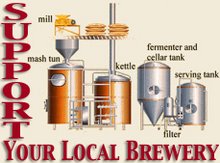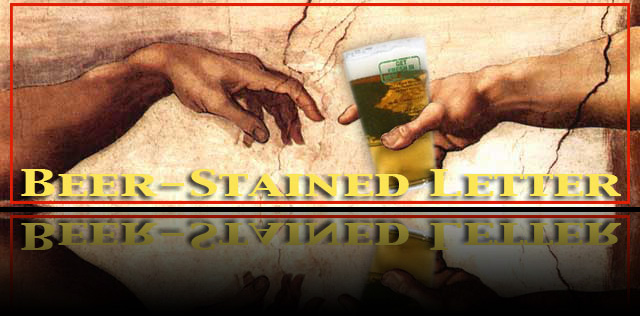A talk with Turtle Stone Brewing's Ben Battiata
 |
| Ben in the Turtle Stone brewhouse area |
Turtle Stone Brewing sidestepped those workhorse styles of the craft beer world to walk a different path toward making a mark on New Jersey's beer scene.
Probably the closest thing to them that Turtle Stone flirts with is a red rye ale and an American stout, the latter a brew that drives sales for the 14-month-old South Jersey production brewery.
But when you look a little deeper into what owners Ben Battiata and Becky Pedersen are up to, you'll notice how that garden and food – jasmine tea, dark roast coffee or sweet potatoes, flowers – informs their brewing to create what are arguably boutique or artisanal beers.
More realistically, though, those ingredients are the answer to what inspires Ben and Becky's creativity and vision as brewers.
More realistically, though, those ingredients are the answer to what inspires Ben and Becky's creativity and vision as brewers.
"We brew with certain things people aren't used to," Ben says. "Sometimes when people try (the beer), they love that it's completely different and that it tastes different. It's not what they're expecting.
"For me, I like to brew what I like. But it's also all part of that trying to create our own identity. I certainly respect the traditional styles of beer. I want to create my own versions of them, whether it's a take on a traditional style and just tweak it a little bit, or just go completely different and kind of ignore some of what people have been using as guidelines for so long."
That principle is what Turtle Stone was founded on, and it's led to brews that re-imagine beer as what it could be, not just what it should be. Recently, Ben took time for a talk about Turtle Stone's first year in business and where he'd like to see the Vineland brewery go this year.
BSL: Describe that first year, what were the highs and the lows?
BB: The highs were definitely getting started, getting our beer out there, having people get to experience our beer, us experiencing their reaction and reception of what we're brewing and want to introduce to the craft beer world. We were hoping to (have) production up a little higher than it is now.
We did a lot of festivals this year, which were a lot of fun, good experience and learned a lot. We have a lot more plans, and hopefully they're going to get implemented soon ...
BSL: Turtle Stone still has some remaining work to do in the brewery space. Can you talk about that, what needs to be done for your 15-barrel brewhouse? (The system was bought used from a brewpub.)
BB: Yeah, 15-barrel system ... We just have some construction to do, some final installation of the equipment. We have our large cold box that we need to get set up, too, with the bright tanks in it ... They're not jacketed, so they have to go in there to regulate temperature. It's a typical brewpub setup, where the bright tanks would be in a cold box and serving directly from the bright tanks ...
Other than that, it's just getting that final construction done, and our tasting room permit. We're really going to do a lot with our tasting room area, bring in local people and get our beer out that way, too.
The other area we want to get into is bottling. That's something we want to introduce fairly soon. We have a saison we want to bottle condition, so that's a beer we want to bring out for the season. It's a dandelion saison, peppercorns and lemongrass.
BSL: This is your first season with it? (The saison is called Dent De Lion, French for lion's tooth.)
BB: We didn't do it last year. By the time we started, it was a little late for us to get that in the season we wanted it. If we had been licensed in January, we probably would have had it ready to go by (March). Vineland is the dandelion capital of the world. We took a play on that and sort of celebrate the dandelion capital of the world status, and in turn make a beer with it, too.
 |
| Becky's brother, Scott Pedersen, festival help |
BB: Red rye and American stout are definitely the two main flagships ... Our American Stout, this year definitely proved that that was our biggest selling beer, most popular beer. It's been probably one of my favorite beers for the last 10 years.
We have the Flor Roja (Spanish for red flower), which is hibiscus, blonde style. It's more of a California common style beer. We introduced that at our launch party. It did really well throughout the summer, then we kind of dialed that back toward the fall, when we had our sweet potato fall seasonal, which was awesome. (Turtle Stone also brews a jasmine green tea beer called Green Snale.)
BSL: What's the process for brewing with sweet potato? There's a lot of starch in there. How do you free up the sugars in that?
BB: We mash it, just like we would the grains. It's pretty much the same process of converting the starch to sugar in (barley) mash. We roast them first; roasting caramelizes some of the sugars. I think it adds a little more of that caramel sweet flavor ...
BSL: How does the beer finish out?
BB: It actually has a clean finish. There's definitely some residual proteins left behind that give it a little bit more mouthfeel. We subtly spiced it with some nutmeg and cinnamon sticks in the boil. We used our house yeast, which is pretty much a version of the American ale yeast. We kind of categorize it as a märzen style beer, even though it's not a lager yeast, just because we called it Oktuberfest. Everything about the base beer was a märzen. We added maple syrup to the bright, which had a really nice effect on the flavor of the beer.
BSL: What hops go with beer like that, something a little more noble-like?
BB: Definitely noble hops. I think I used Sterling. Definitely no Cascades. You don't want that citrus flavor. Sometimes that will take over a beer and conflict with the flavors you're going for.
BSL: There's been a number of coffee stouts from Jersey brewers over the past year, working with coffee roasters local to them. Talk a little about yours.
BB: We worked with a roaster in Millville, Cafe Magnum Opus, and did our Filboid Stout. We did a nice Sumatran roast ... it's a lesser acidic region. We did a cold toddy in the bright, as opposed to in the boil. When you expose a lot of heat to coffee you extract a lot of tannins.
It was a really, really good beer, a little more expensive to make for us. We also used cacao nibs – Ecuadorian cacao nibs – and baker's chocolate. The nibs really give it a nuttier kind of flavor and nose.You get a little of that chocolaty nose, but you don't get much of that chocolaty flavor from it, so we also used dark baker's chocolate to get a really nice bitter dark chocolate.
BSL: And this is a beer you envision bottling at some point?
BB: That was the one beer we wanted to bottle for Christmas. That was one of the first ones we were going to try to do, but we weren't ready yet to bottle. We actually wanted to do packages because we get a lot of people asking ... for us, the market around here seems like it would be easier to get on the liquor store shelves. I have some liquor stores asking for our beer, but we're not packaging yet.
BSL: Tasting rooms are an important side component for production brewers now, given the law change last fall that lets you retail in more ways now versus the past. What's your timetable for getting that part going?
BB: We want to have something open by the summer. We want to be able to get some of that shore traffic coming from Philly and Delaware to stop on their way, be able to actually get people in here. All throughout the year, we've had calls and emails, people wanting to stop in for tours and get growler fills, and the locals who want growler fills. So we really want to have something going by the summertime. That's one of our main focuses for this year.
Editor's Note: Video from 2011, a small festival in South Jersey.
Editor's Note: Video from 2011, a small festival in South Jersey.














No comments:
Post a Comment